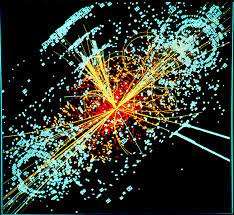

“GOD PARTICLE” AND THE ORIGIN OF THE UNIVERSE
Dr. George Samuel
The news on the 4th of July regarding the “God particle” or Higgs Boson is fresh in our minds. As you know, it is related to the study concerning the origin of the universe, especially on tracing the way in which the elementary particles acquired mass and turned out to be matter. Scientist Peter Higgs, of Cambridge University, in 1964 came up with a theory for the role of Boson particles in this process and therefore the name Higgs Boson. Interestingly, scientist Sathyendra Nath Bose of Calcutta had first proposed this in 1924. Because of the difficulty of isolating and identifying Higgs Boson, scientist Leon Liddermann made a comment that it is a “god damn” particle. But in his book it appeared as “god particle” an editing error, perhaps. Although the particle Higgs Boson is popularly known by the name “god particle,” the term is not derived in the sense of God being in it. However, we cannot write God off the picture while looking at the way the universe is designed.
Creator of the Universe
About sixty years ago, a vast majority of leading scientists believed that the discoveries in modern science have eliminated the need to look for a supernatural creator. In this context, the declaration in the Bible “In the beginning God created” (Genesis 1:1) becomes one of the most controversial scientific statements ever made. But the tremendous new discoveries of modern science made during the past six decades provide compelling evidence that a supernatural creator created the universe as the biblical book of Genesis affirms. Today we have the benefit of Astrophysics, Cosmology, Molecular Biology, Information Technology and the like which provide important milestones in evaluating possibilities regarding the origin of the universe and life in it. Till the former half of the 20th century the universe was measureless. Now we can see and measure of its limits and characteristics. New technical and theoretical tools have enabled astronomers to measure some of the most important features of our universe, our galaxy and our solar system. If there is a creator who brought the universe into existence, He must be intelligent and powerful. The scientifically revealed creator uniquely and decisively matches the character and the characteristics of the biblically revealed God.
The Beginning of the Universe
As we look back, we can see that scientists themselves differed in their views on the existence of the universe. Some of them thought they had to accept that the universe had existed for ever. There were others who believed that there had to be a beginning at some point in the indefinite past. As the age of the universe is measurable and limited, the philosophical systems depending on its infinite age have no foundation now. According to the “Big Bang” theory, about 14 billion years ago (now the figure is 13.6 billion years) the universe began with an “explosion” of cosmic dimensions. Stephen W. Hawking, a theoretical physicist who is currently the Lucasian Professor of Mathematics at Cambridge University, (a post once held by Sir Isaac Newton), says in his book A Brief History of Time, “So long as the universe had a beginning, we could suppose it had a creator”. He asserts that the universe has an origin out of nothing in the sense that there is absolutely nothing that comes before it. He wasn’t able to successfully write God off the picture.
A Micro-version of the Explosion
The scientists of the European Organization for Nuclear Research (CERN) conducted an experiment, a “micro-version” of the big bang under controlled conditions. The specific task was to isolate and identify Higgs Boson and the procedure adopted was Proton collision. For this they used the Large Hadron Collider, a 27 kms tunnel that was made about 100 meters below the ground at the border of Switzerland and France. The experiment was to collect data related to the formation of matter by the ejected elementary particles such as fermions like quarks and leptons gaining mass by the intervention of Higgs Bosons. Beams of Protons were ejected or shot at a speed very close to the speed of light, and they collided with each other at the rate of 600 million collisions per second at a temperature equivalent to that in the core of the sun in order to separate the particles! The report is that the scientists were successful in proving the existence of a particle that has very similar characteristics of Higgs Boson – i.e. identified a boson which is “consistent with” the one Peter Higgs proposed 48 years ago. According to the elementary particle theory, the “Higgs field” with Higgs boson made these particles ejected during the original big bang explosion to become matter and form the present universe – i.e. the universe composed of a trillion galaxies with each galaxy containing 100 billion stars in it.
The ‘Where’ and ‘How’ of Big Bang Explosion
The term “Big Bang” was coined at the time when scientists were originally speculating on the origin of the universe based on the theory of general relativity. The equations with the updates based on experimental physics indicate that the universe started from nothing and burst into existence. Using these equations of general relativity, scientists tried to trace that “explosion” backward, to its origin, to an instant when the entire physical universe burst forth from a single point of infinite density. That point when the universe originated from a point of no size at all is called “Singularity”. Singularity is the whole of three dimensional space compressed to zero size. This infinitely shrunken space actually represents a boundary at which space ceases to exist.
The theories designed to avoid the beginning of the universe in order to escape the implications of a cause have turned out to be untenable. The probability of something physical coming from nothing is zero. Not a single physical state or event known can originate from nothing. General relativity points to the need for a cause that transcends the domains of time, space, matter and energy. Some suggest that the universe and everything in it came into existence by chance. But chance has no power to cause anything. Chance is a mathematical abstraction with no real existence. Since it is nothing, it cannot do anything. Moreover, intelligent life has the ability to think and act in a purposeful way. An eternally self-subsistent Being is no more improbable than a self-subsisted event emerging from no cause.
Development of the Universe for the Existence of Life
From its inception, the universe had to be fine-tuned to an incomprehensible precision for the existence of life. The precision seen in the universe is so utterly fantastic and mathematically accurate, that it is just plain silly to think it could have been an accident. The earth had to be located in the right part of the galaxy for life to appear. Some of the critical parameters include earth’s distance from the sun, sun’s mass and size, its location relative to the centre of the galaxy, tilt of planetary axis which is necessary for seasons, ratio of oceans to continents, Oxygen-Nitrogen ratio, Carbon dioxide level, speed of light, atmospheric transparency and the like. About 152 such critical parameters have been identified. A small change in any of these would make life impossible. All the seemingly arbitrary and unrelated constants in physics are precisely the values required to have a universe capable of producing and sustaining life. These laws and constants conspire in a mathematically incredible way to make life in the universe possible. There is no fundamental reason why these values have to be the way they are.
Purposeful Design
We can see from the above mentioned parameters that the conditions for life are far from random chance. The fine-tuning of the universe points powerfully towards an Intelligent Designer. The scientific evidence of contemporary Cosmology is pointing toward a universe designed for a hospitable cosmic habitat. The whole realm of nature shouts about the design of the universe.
Design always implies a purpose. If so, it must include the entire creation. Not only the universe, but all in it are in the plan and purpose of God - that includes each one of us! We are wonderfully made to accomplish His purpose. Moreover, we are designed to experience and enjoy higher things in life that are beyond the temporal. Purpose, surely, is derived from our beliefs. What we believe therefore is important.
Conclusion
Modern science has not yet made ‘faith’ unacceptable. Scientific advance is an ally, not an enemy of faith. Formerly, we had to maintain our beliefs only by faith in the Bible to face the contrary arguments raised on scientific grounds. Now we can stand confidently within the biblical truth, knowing it is in line with scientific advance. In this space-time existence, God meets the demands of our mind and quenches the thirst of our heart. We are, therefore, able to love God with ‘all our heart and mind.’




